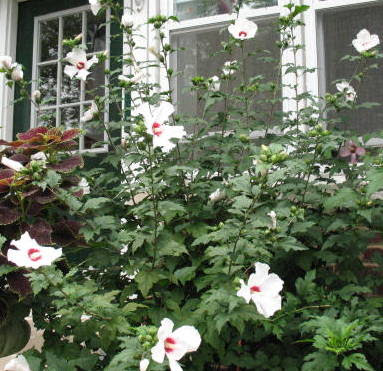We are nearing the end of the dog days of summer -- a time during which only the prospect of a delicious garden tomato can push me outdoors voluntarily. Yet some of our prettiest flowers bloom in August. We can consider them our reward for planting we did earlier.
Today I want to show off two quite different forms of hibiscus, both of which bloom in August and September.
The first is familiar to most of us. Only the names are confusing. Known here as Rose of Sharon and in Britain as Rose mallow, even its Latin name is confusing. Linnaeus, the founder of modern taxonomy, called it Hibiscus syriacus, but it has no connection to Syria. It also has no connection to the plain of Sharon in Israel. In fact, the name first appears as a mistranslation in the King James Bible. Hibiscus syriacus is the national flower of South Korea and has been cultivated there for generations.
Besides its white to red to purple blooms, the Rose of Sharon has many other virtues for the Chicago garden: it is not picky about soil pH; it tolerates a fair amount of shade; it can get by in all but very wet and very dry soil. It is an upright shrub that can reach 8-12 feet high while only 6-9 feet wide. And it is easy to prune in early spring when the weather is cool and you have nothing better to do.
The other hibiscus hardy enough to grow here has the virtue of agreement in the English speaking world on its name. Both the US and the UK call it rose mallow. It is also called hardy hibiscus to distinguish it from its many tropical cousins. In Latin confusion reigns over many sub-species, but most plant are bought as commercial hybrids, so we don't care.
My rose mallows are now about three high and may get a little higher, but there are others that can get up to 6 feet with flowers as big as dinner plates. Perennial hibiscus, too, are tolerant of most conditions we face in Chicago. If your yard has a bit of the blah's in these dog days of summer a few hibiscus may be just what you need.






